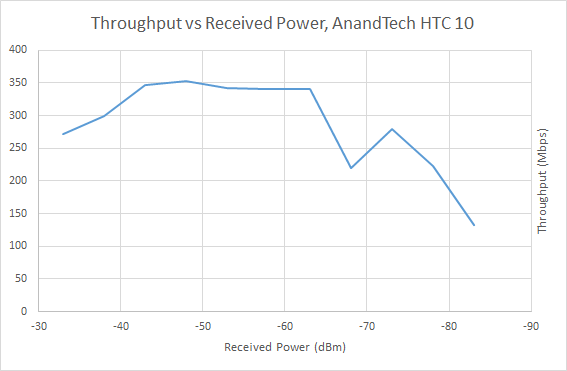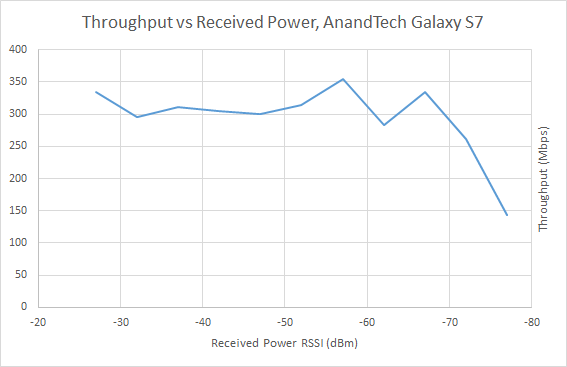The Samsung Galaxy S7 and S7 edge Review: Part 2
by Joshua Ho on July 5, 2016 8:00 AM ESTWiFi Testing with Ixia IoT
As previously discussed, RF testing has always been a major unknown to some extent because environmental factors make it extremely difficult to tell exactly what is going on with the system. I don’t think it really needs to be said but previous reviews and any controversy regarding the quality of RF has always lead to a ring of confusion and back and forth with no clear-cut answers, at least in the public domain. The Transformer Prime and Pixel C reception issues have all been cases where I’ve seen a lot of confusion over whether a problem really existed in the hardware, software, or with the end user.
Most people really don’t have any understanding of how wireless transmission works, probably because it’s not really something you can see. As far as I know, no one is capable of seeing radio waves, even at high frequencies like 60 GHz. Of course, the problem is that for quite some time our testing was also not really ideal for seeing the quality of an RF implementation. While iPerf does provide some useful data, free space testing means that we’re dealing with channel conditions that inherently cannot be controlled. As a result, the only sensible test we could do with iPerf was focus on maximum throughput in the best conditions we could provide. The only thing that this can highlight is the upper bound of efficiency for WiFi due to the carrier sense multiple access scheme in most cases, and rarely detects a whole class of problems that affect user experience on WiFi.
In order to test these things we’ve moved to using a proper testing system that is actually used by at least a few OEMs today, namely Ixia IoT. While we discussed the possibilities for testing, at this time due to the RF isolation chamber used we are limited to AP simulation only, so we can’t properly simulate clients in the channel without restricting ourselves to a single spatial stream for both the AP and client. This wouldn’t be a very useful test if set up in this manner as most devices today that we’re testing have support for two spatial streams, and many routers have three or even four spatial streams at this point.
The first set of results we can talk about that will be of interest is rate vs range. This is a fairly simple test at a conceptual level, as it simply tries to see how well a device can maintain its performance in the face of reducing signal to noise ratio for a given modulation and coding scheme. This is a good high level test of how well a device can maintain a connection as reception degrades. In this test the HTC 10 had an initial RSSI of -28 dBm while the GS7 was at -21 dBm and the iPhone 6s at -22 dBm, which allows us to calculate the path loss and determine the RSSI as a function of the transmit power.
The results of this test are interesting to say the least. Off the bat, every device had different RSSIs measured, so this meant that everything had different levels of path loss. The HTC 10 seemed to have the most path loss, while the Galaxy S7 and iPhone 6s were functionally identical. However it looks like RSSI is really an insufficient metric here because while the iPhone 6s was able to reach maximum throughput using NSS 2 MCS 8, the HTC 10 and Galaxy S7 did its best at NSS 2 MCS 4 or 5. I suspect this may be just due to placement as device positioning strongly affects MIMO as receive-side spatial correlation reduces the gains that MIMO can provide. Regardless, the HTC 10 somehow manages to beat the Galaxy S7 through much of the curve, but for some reason suffers from a reduction in throughput at higher transmit power. It's worth mentioning though that this test doesn't allow for testing of antenna gain or similar tests. Given various levels of futzing about with the device positioning in the test chamber I'm fairly confident that the Galaxy S7 is consistently better with regard to path loss, so even if it doesn't perform as well at a given RSSI it tends to have a higher RSSI than the HTC 10 by about 5 dBm which is fairly significant.
Finally, the other test that we can run at this time is the roaming latency test, which tests how well a device can hop from one access point to another as the received transmit power rises and falls. If you ever rely on WiFi to work as you walk around any building larger than a single apartment unit, you’re going to feel the effects of high roaming latency as VOIP calls or any real-time network application will either experience interruption or drop altogether if roaming is not implemented properly.

In the case of the Galaxy S7, roaming latency is honestly rather wanting. In the best case the Galaxy S7's roaming latency appears to be acceptable, but it's still significantly worse than the best we've seen so far. It seems that Samsung's algorithms have issues with edge cases as I've seen multiple instances so far where the device just can't handle roaming consistently. Despite consistent positioning and identical test setup I've seen cases where the Galaxy S7 has problems with consistent roaming. Even with the simple case of 10 dBm to -45 dBm at 3 dBm drop per second, I've encountered weirdness where the device drops from the network altogether claiming that the password given was incorrect (it wasn't) or a few successful handovers followed by getting stuck on a single access point or dropping from the network entirely. Even in the best set of trials performed I still saw 3 of 64 trials fail to roam correctly. The performance is certainly far better than something like the Google Pixel C, but Samsung should really be focusing on improving here.













266 Comments
View All Comments
shm224 - Thursday, July 14, 2016 - link
any idea why Anandtech is still using web/javascript benchmarks that are intended to measure software/javascript engine performance to measure the system / SOC performance?ozmick1 - Saturday, July 16, 2016 - link
The material (Samsung has told me plain glass and plastic) used over the rear camera lens if too fragile. Many owners are starting to complain of it breaking for no apparent reason as reported on Samsung's US Community website. Buyer beware with the S7 as it made from not-fit-for-purpose material. Samsung even told me that to prevent the rear lens from breaking - to leave the phone on the desk. Buyer beware with the S7.FourEyedGeek - Monday, July 18, 2016 - link
I just got the phone and I really like it. I used the Samsung Galaxy S6 Edge for a couple of months and wasn't a fan, this is better in all the little things.The phone is snappy, interface moves smoothly and opening up applications leaves me with minimal load times. Mine has 32GB but is backed up with 200GB, I move large applications over to the SD card as a way of keeping the inbuilt a free as possible.
It takes high quality pictures, not as nice as my DSLR but still good for a smartphone. The games I run play very smooth, much faster than the S6 Edge, my model uses the Exynos 8890.
I've set up finger print scan, but isn't consistent enough for my liking, haven't used Samsung Pay and I'm not sure I will either but ny favourite cool feature is the water proofing. Used my phone under water for brief moments with my son and we love it. Make sure it is fully charged before dunking as the excellent moisture detection feature prevents charging until it is dry.
BuddyRich - Monday, July 18, 2016 - link
Im rocking the S7 (not Edge - didn't like the cureved edges), while I disagree with some of review, one thing I have noticed, and you are the only other review to mention it, is the Camera lens flare issue with bright light sources at night. Not sure whats going on but I have the same issue with mine (Canadian S7 with the Exynos and different camera senor than 820s I believe, but same issue.) For an otherwise good camera this ruins it for me. Not everyone mentions it, but did you ever get a comment from Samsung on this, is it a defect perhaps? Its almost like they didn't put an AR coating on the lense or something.InspectHerGadget - Sunday, July 31, 2016 - link
I owned an S6 then the Note 5 and now the iPhone 6S Plus. I had previous to these, a Nokia 1520. All are great phones. The stand out feature of both the 1520 and 6S Plus is the battery life. The S7 will have the same issues with battery life that the S6 had, just slightly longer due to the larger battery. It isn't good enough and even the Note 5 battery life was only just adequate.I think that the review is outstanding and I appreciate the thorough approach to testing and reviewing. These phones are complex devices and every component needs to be analysed and tested. If you are going to shell out lots of money, you need to be sure of what you are buying.
If a manufacturer such as Apple are shown to put together an outstanding device where every aspect of the device is exemplary, then the accolades are deserved. This doesn't happen by chance but is the result of blood, sweat and tears and thorough testing also.
It is fair enough that Anandtech point out where Samsung have fallen short and why. It will put Samsung on notice to do better. Samsung are sloppy with what they do and they can't afford to be when up against Apple who make very few mistakes.
Bigbank - Tuesday, January 9, 2018 - link
You need to have field experience.S7 is the best, most versatile, best ROCKING audio on video playback.
I'm sure the HTV will do a goid job, but if u can, u should.
I'm sad because I can't allocate enough memory to 1080p, much less 1920p.
Nice site